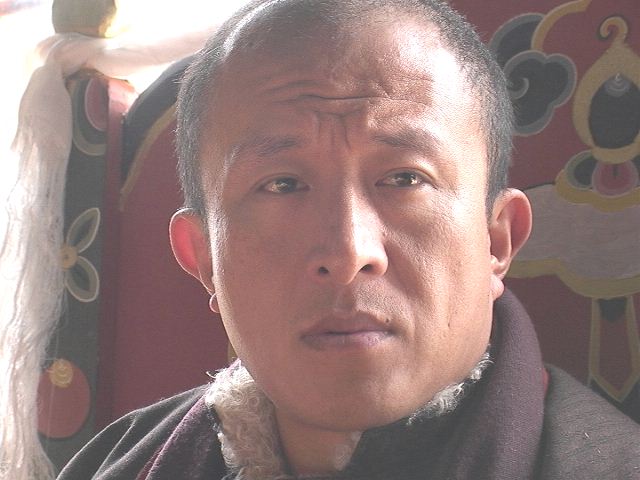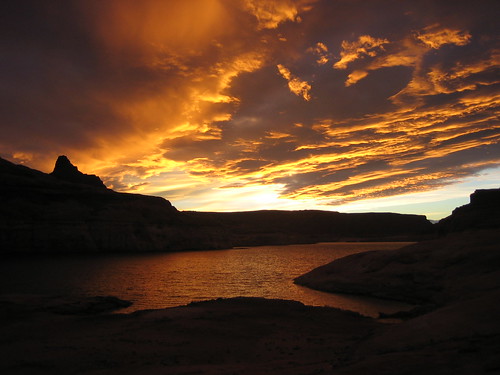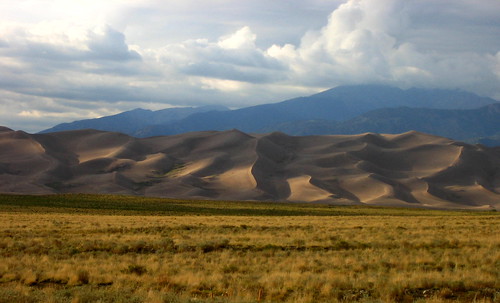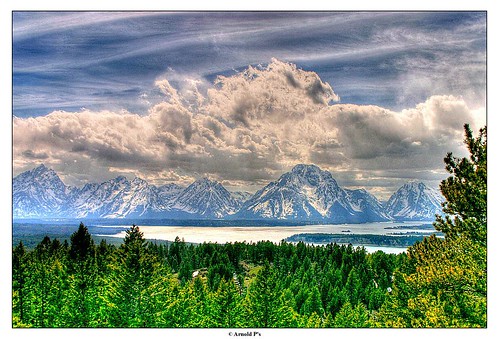There are some people who confuse Buddhism as a part of Hinduism. With the growing interests in new age and mystic teachings from teachers such as Eckhart Tolle, there is also confusion among some people mistaking the 'Enlightenment' mentioned by Eckhart to be the same as the Buddha's Enlightenment. Despite some similarities, the 'Enlightenment' of Hinduism, Christian mysticism, Sufism and Taoism are fundamentally different from that of Buddhism. That is because the fundamental view of Buddhism is distinct from all other religions.
I find the article below very beneficial in finding out what Buddhism really is. The veil of tradition has prevented some from seeing Buddhism apart from its many rituals and traditional beliefs. Although many readers might have already read about the Four Seals of Dharma, I strongly recommend reading this article in entirety with an open mind to benefit from this very wise teacher's insight.
Colin (picture source: flickr.com)
(picture source: flickr.com)
(Also see: siddharthasintent.org)
Shambhala Sun | March 2000
Buddhism In a Nutshell: The Four Seals of Dharma
by Dzongsar Khyentse Rinpoche
People often ask me: “What is Buddhism in a nutshell?” Or they ask, “What is the particular view or philosophy of Buddhism?”
Unfortunately, in the West Buddhism seems to have landed in the religious department, even in the self-help or self-improvement department, and clearly it’s in the trendy meditation department. I would like to challenge the popular definition of Buddhist meditation.
Many people think meditation has something to do with relaxation, with watching the sunset or watching the waves at the beach. Charming phrases like “letting go” and “being carefree” come to mind. From a Buddhist point of view, meditation is slightly more than that.
First, I think we need to talk about the real context of Buddhist meditation. This is referred to as the view, meditation and action; taken together, these constitute quite a skillful way of understanding the path. Even though we may not use such expressions in everyday life, if we think about it, we always act according to a certain view, meditation and action. For instance, if we want to buy a car, we choose the one we think is the best, most reliable and so on. So the “view,” in this case, is the idea or belief that we have, that is, that the car is a good one. Then the “meditation” is contemplating and getting used to the idea, and the “action” is actually buying the car, driving it and using it. This process is not necessarily something Buddhist; it’s something we’re doing all the time. You don’t have to call it view, meditation and action. You can think of it as “idea,” “getting used to,” and “obtaining.”
So what is the particular view that Buddhists try to get used to? Buddhism is distinguished by four characteristics, or “seals.” Actually, if all these four seals are found in a path or a philosophy, it doesn’t matter whether you call it Buddhist or not. You can call it what you like; the words “Buddhist” or “Buddhism” are not important. The point is that if this path contains these four seals, it can be considered the path of the Buddha.
Therefore, these four characteristics are called “the Four Seals of Dharma.” They are:
All compounded things are impermanent.
All emotions are painful. This is something that only Buddhists would talk about. Many religions worship things like love with celebration and songs. Buddhists think, “This is all suffering.”
All phenomena are empty; they are without inherent existence. This is actually the ultimate view of Buddhism; the other three are grounded on this third seal.
The fourth seal is that nirvana is beyond extremes.
Without these four seals, the Buddhist path would become theistic, religious dogma, and its whole purpose would be lost. On the other hand, you could have a surfer giving you teachings on how to sit on a beach watching a sunset: if what he says contains all these four seals, it would be Buddhism. The Tibetans, the Chinese, or the Japanese might not like it, but teaching doesn’t have to be in a “traditional” form. The four seals are quite interrelated, as you will see.
 (picture source: flickr.com)
(picture source: flickr.com)The First Seal:
All Compounded Things are Impermanent
Every phenomenon we can think of is compounded, and therefore subject to impermanence. Certain aspects of impermanence, like the changing of the weather, we can accept easily, but there are equally obvious things that we don’t accept.
For instance, our body is visibly impermanent and getting older every day, and yet this is something we don’t want to accept. Certain popular magazines that cater to youth and beauty exploit this attitude. In terms of view, meditation and action, their readers might have a view—thinking in terms of not aging or escaping the aging process somehow. They contemplate this view of permanence, and their consequent action is to go to fitness centers and undergo plastic surgery and all sorts of other hassles.
Enlightened beings would think that this is ridiculous and based on a wrong view. Regarding these different aspects of impermanence, getting old and dying, the changing of the weather, etc., Buddhists have a single statement, namely this first seal: phenomena are impermanent because they are compounded. Anything that is assembled will, sooner or later, come apart.
When we say “compounded,” that includes the dimensions of space and time. Time is compounded and therefore impermanent: without the past and future, there is no such thing as the present. If the present moment were permanent, there would be no future, since the present would always be there. Every act you do—let’s say, plant a flower or sing a song—has a beginning, a middle and an end. If, in the singing of a song, the beginning, middle or end were missing, there would be no such thing as singing a song, would there? That means that singing a song is something compounded.
 (picture source: flickr.com)
(picture source: flickr.com)“So what?” we ask. “Why should we bother about that? What’s the big deal? It has a beginning, middle, and end—so what?” It’s not that Buddhists are really worried about beginnings, middles or ends; that’s not the problem. The problem is that when there is composition and impermanence, as there is with temporal and material things, there is uncertainty and pain.
Some people think that Buddhists are pessimistic, always talking about death, impermanence and aging. But that is not necessarily true. Impermanence is a relief! I don’t have a BMW today and it is thanks to the impermanence of that fact that I might have one tomorrow. Without impermanence, I am stuck with the non-possession of a BMW, and I can never have one. I might feel severely depressed today and, thanks to impermanence, I might feel great tomorrow. Impermanence is not necessarily bad news; it depends on the way you understand it. Even if today your BMW gets scratched by a vandal, or your best friend lets you down, if you have a view of impermanence, you won’t be so worried.
Delusion arises when we don’t acknowledge that all compounded things are impermanent. But when we realize this truth, deep down and not just intellectually, that’s what we call liberation: release from this one-pointed, narrow-minded belief in permanence. Everything, whether you like it or not—even the path, the precious Buddhist path—is compounded. It has a beginning, it has a middle and it has an end.
When you understand that “all compounded things are impermanent,” you are prepared to accept the experience of loss. Since everything is impermanent, this is to be expected.
 (picture source: flickr.com)
(picture source: flickr.com)The Second Seal:
All Emotions are Painful
The Tibetan word for emotion in this context is zagche, which means “contaminated” or “stained,” in the sense of being permeated by confusion or duality.
Certain emotions, such as aggression or jealousy, we naturally regard as pain. But what about love and affection, kindness and devotion, those nice, light and lovely emotions? We don’t think of them as painful; nevertheless, they imply duality, and this means that, in the end, they are a source of pain.
The dualistic mind includes almost every thought we have. Why is this painful? Because it is mistaken. Every dualistic mind is a mistaken mind, a mind that doesn’t understand the nature of things. So how are we to understand duality? It is subject and object: ourselves on the one hand and our experience on the other. This kind of dualistic perception is mistaken, as we can see in the case of different persons perceiving the same object in different ways. A man might think a certain woman is beautiful and that is his truth. But if that were some kind of absolute, independent kind of truth, then everyone else also would have to see her as beautiful as well. Clearly, this is not a truth that is independent of everything else. It is dependent on your mind; it is your own projection.
The dualistic mind creates a lot of expectations—a lot of hope, a lot of fear. Whenever there is a dualistic mind, there is hope and fear. Hope is perfect, systematized pain. We tend to think that hope is not painful, but actually it’s a big pain. As for the pain of fear, that’s not something we need to explain.
The Buddha said, “Understand suffering.” That is the first Noble Truth. Many of us mistake pain for pleasure—the pleasure we now have is actually the very cause of the pain that we are going to get sooner or later. Another Buddhist way of explaining this is to say that when a big pain becomes smaller, we call it pleasure. That’s what we call happiness.
 (picture source: flickr.com)
(picture source: flickr.com)Moreover, emotion does not have some kind of inherently real existence. When thirsty people see a mirage of water, they have a feeling of relief: “Great, there’s some water!” But as they get closer, the mirage disappears. That is an important aspect of emotion: emotion is something that does not have an independent existence.
This is why Buddhists conclude that all emotions are painful. It is because they are impermanent and dualistic that they are uncertain and always accompanied by hopes and fears. But ultimately, they don’t have, and never have had, an inherently existent nature, so, in a way, they are not worth much. Everything we create through our emotions is, in the end, completely futile and painful. This is why Buddhists do shamatha and vipashyana meditation—this helps to loosen the grip that our emotions have on us, and the obsessions we have because of them.
Question: Is compassion an emotion?
People like us have dualistic compassion, whereas the Buddha’s compassion does not involve subject and object. From a buddha’s point of view, compassion could never involve subject and object. This is what is called mahakaruna—great compassion.
I’m having difficulty accepting that all emotions are pain.
Okay, if you want a more philosophical expression, you can drop the word “emotion” and simply say, “All that is dualistic is pain.” But I like using the word “emotion” because it provokes us.
Isn’t pain impermanent?
Yeah! If you know this, then you’re all right. It’s because we don’t know this that we go through a lot of hassles trying to solve our problems. And that is the second biggest problem we have—trying to solve our problems.
 (picture source: flickr.com)
(picture source: flickr.com)The Third Seal:
All Phenomena are Empty; They Are Without Inherent Existence
When we say “all,” that means everything, including the Buddha, enlightenment, and the path. Buddhists define a phenomenon as something with characteristics, and as an object that is conceived by a subject. To hold that an object is something external is ignorance, and it is this that prevents us from seeing the truth of that object.
The truth of a phenomenon is called shunyata, emptiness, which implies that the phenomenon does not possess a truly existent essence or nature. When a deluded person or subject sees something, the object seen is interpreted as something really existent. However, as you can see, the existence imputed by the subject is a mistaken assumption. Such an assumption is based on the different conditions that make an object appear to be true; this, however, is not how the object really is. It’s like when we see a mirage: there is no truly existing object there, even though it appears that way. With emptiness, the Buddha meant that things do not truly exist as we mistakenly believe they do, and that they are really empty of that falsely imputed existence.
It is because they believe in what are really just confused projections that sentient beings suffer. It was as a remedy for this that the Buddha taught the Dharma. Put very simply, when we talk about emptiness, we mean that the way things appear is not the way they actually are. As I said before when speaking about emotions, you may see a mirage and think it is something real, but when you get close, the mirage disappears, however real it may have seemed to begin with.
Emptiness can sometimes be referred to as dharmakaya, and in a different context we could say that the dharmakaya is permanent, never changing, all pervasive, and use all sorts of beautiful, poetic words. These are the mystical expressions that belong to the path, but for the moment, we are still at the ground stage, trying to get an intellectual understanding. On the path, we might portray Buddha Vajradhara as a symbol of dharmakaya, or emptiness, but from an academic point of view, even to think of painting the dharmakaya is a mistake.
The Buddha taught three different approaches on three separate occasions. These are known as The Three Turnings of the Wheel, but they can be summed up in a single phrase: “Mind; there is no mind; mind is luminosity.”
 (picture source: flickr.com)
(picture source: flickr.com)The first, “Mind,” refers to the first set of teachings and shows that the Buddha taught that there is a “mind.” This was to dispel the nihilistic view that there is no heaven, no hell, no cause and effect. Then, when the Buddha said, “There is no mind,” he meant that mind is just a concept and that there is no such thing as a truly existing mind. Finally, when he said, “Mind is luminous,” he was referring to buddhanature, the undeluded or primordially existing wisdom.
The great commentator Nagarjuna said that the purpose of the first turning was to get rid of non-virtue. Where does the non-virtue come from? It comes from being either eternalist or nihilist. So in order to put an end to non-virtuous deeds and thoughts, the Buddha gave his first teaching. The second turning of the Dharma-wheel, when the Buddha spoke about emptiness, was presented in order to dispel clinging to a “truly existent self” and to “truly existent phenomena.” Finally, the teachings of the third turning were given to dispel all views, even the view of no-self. The Buddha’s three sets of teaching do not seek to introduce something new; their purpose is simply to clear away confusion.
As Buddhists we practice compassion, but if we lack an understanding of this third seal—that all phenomena are empty—our compassion can backfire. If you are attached to the goal of compassion when trying to solve a problem, you might not notice that your idea of the solution is entirely based on your own personal interpretation. And you might end up as a victim of hope and fear, and consequently of disappointment. You start by becoming a “good mahayana practitioner,” and, once or twice, you try to help sentient beings. But if you have no understanding of this third seal, you’ll get tired and give up helping sentient beings.
There is another kind of a problem that arises from not understanding emptiness. It occurs with rather superficial and even jaded Buddhists. Somehow, within Buddhist circles, if you don’t accept emptiness, you are not cool. So we pretend that we appreciate emptiness and pretend to meditate on it. But if we don’t understand it properly, a bad side effect can occur. We might say, “Oh, everything’s emptiness. I can do whatever I like.” So we ignore and violate the details of karma, the responsibility for our action. We become “inelegant,” and we discourage others in the bargain. His Holiness the Dalai Lama often speaks of this downfall of not understanding emptiness. A correct understanding of emptiness leads us to see how things are related, and how we are responsible for our world.
 (picture source: flickr.com)
(picture source: flickr.com)You can read millions of pages on this subject. Nagarjuna alone wrote five different commentaries mostly dedicated to this, and then there are the commentaries by his followers. There are endless teachings on establishing this view. In Mahayana temples or monasteries people chant the Prajnaparamita Heart Sutra—this is also a teaching on the third seal.
Philosophies or religions might say, “Things are illusion, the world is maya, illusion,” but there are always one or two items left behind that are regarded as truly existent: God, cosmic energy, whatever. In Buddhism, this is not the case. Everything in samsara and nirvana—from the Buddha’s head to a piece of bread—everything is emptiness. There is nothing that is not included in ultimate truth.
Question: If we ourselves are dualistic, can we ever understand emptiness, which is something beyond description?
Buddhists are very slippery. You’re right. You can never talk about absolute emptiness, but you can talk about an “image” of emptiness—something that you can evaluate and contemplate so that, in the end, you can get to the real emptiness. You may say, “Ah, that’s just too easy; that’s such crap.” But to that the Buddhists say, “Too bad, that’s how things work.” If you need to meet someone whom you have never met, I can describe him to you or show you a photograph of him. And with the help of that photo image, you can go and find the real person.
Ultimately speaking, the path is irrational, but relatively speaking, it’s very rational because it uses the relative conventions of our world. When I’m talking about emptiness, everything that I’m saying has to do with this “image” emptiness. I can’t show you real emptiness but I can tell you why things don’t exist inherently.
In Buddhism there’s so much iconography that you might think it was the object of meditation or an object of worship. But, from your teaching, am I to understand that this is all non-existent?
When you go to a temple, you will see many beautiful statues, colors and symbols. These are important for the path. These all belong to what we call “image-wisdom,” “image-emptiness.” However, while we follow the path and apply its methods, it is important to know that the path itself is ultimately an illusion. Actually, it is only then that we can properly appreciate it.
 (picture source: flickr.com)
(picture source: flickr.com)The Fourth Seal
Nirvana is Beyond Extremes
Now that I have explained emptiness, I feel that the fourth seal, “Nirvana is beyond extremes,” has also been covered. But briefly, this last seal is also something uniquely Buddhist. In many philosophies or religions, the final goal is something that you can hold on to and keep. The final goal is the only thing that truly exists. But nirvana is not fabricated, so it is not something to be held on to. It is referred to as “beyond extremes.”
We somehow think that we can go somewhere where we’ll have a better sofa seat, a better shower system, a better sewer system, a nirvana where you don’t even have to have a remote control, where everything is there the moment you think of it. But as I said earlier, it’s not that we are adding something new that was not there before. Nirvana is achieved when you remove everything that was artificial and obscuring.
It doesn’t matter whether you are a monk or a nun who has renounced worldly life or you are a yogi practicing profound tantric methods. If, when you try to abandon or transform attachment to your own experiences, you don’t understand these four seals, you end up regarding the contents of your mind as the manifestations of something evil, diabolical and bad. If that’s what you do, you are far from the truth. And the whole point of Buddhism is to make you understand the truth. If there were some true permanence in compounded phenomena; if there were true pleasure in the emotions, the Buddha would have been the first to recommend them, saying, “Please keep and treasure these.” But thanks to his great compassion, he didn’t, for he wanted us to have what is true, what is real.
When you have a clear understanding of these four seals as the ground of your practice, you will feel comfortable no matter what happens to you. As long as you have these four as your view, nothing can go wrong. Whoever holds these four, in their heart, or in their head, and contemplates them, is a Buddhist. There is no need for such a person even to be called a Buddhist. He or she is by definition a follower of the Buddha.
Dzongsar Jamyang Khyentse Rinpoche was born in Bhutan in 1961 and was recognized as the second reincarnation of the nineteenth-century master Jamyang Khyentse Wangpo. He has studied with and been empowered by some of the greatest Tibetan masters of this century, notably the late Dilgo Khyentse Rinpoche and the late Dudjom Rinpoche. Dzongsar Khyentse Rinpoche supervises his traditional seat of Dzongsar Monastery in Eastern Tibet, as well as newly established colleges in India and Bhutan. He has also established meditation centers in Australia, North America and the Far East. Recently, Dzongsar Khyentse Rinpoche won critical acclaim for his first feature length movie, The Cup, produced under his name Khyentse Norbu. Further information on Dzongsar Khyentse Rinpoche and his activities is available at www.siddharthasintent.org. This article is based on a talk entitled, “What Buddhism Is, and Is Not,” given in Sydney, Australia in April of 1999.
Buddhism In a Nutshell: The Four Seals of Dharma, Dzongsar Khyentse Rinpoche, Shambhala Sun, March 2000.
--------------------------------------
Technorati: buddhism essence dharma seal Buddhism Buddha Buddhist Dharma Compassion Wisdom Religion Meditation Zen Philosophy Spirituality Inspiration Peace Insight









